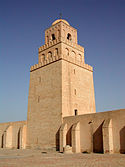Abu Imran al-Fasi
Abu 'Imran al-Fasi | |
|---|---|
| Personal | |
| Born | 974 |
| Died | June 8, 1039 |
| Religion | Islam |
| Denomination | Sunni |
| Jurisprudence | Maliki |
| Creed | Ash'ari[1][2] |
| Muslim leader | |
Influenced by | |
Abu Imran Musa ibn Isa ibn Abi 'l-Hajj (or Hajjaj) al-Fasi (Arabic: أبو عمران موسى بن عيسى بن أبي الحاج الفاسي) (also simply known as Abu 'Imran al-Fasi; born between 975 and 978, died 8 June 1039) was a Moroccan Maliki faqīh born at Fez to a Berber[4] or Arab[5] family whose nisba is impossible to reconstruct.
Abu ‘Imran al-Fasi was probably born between 975 and 978 at Fes. He went to Ifriqiya, where he settled in Kairouan and studied under al-Kabisi (died 1012).[6] With al-Kabisi, he introduced the young Ibn Sharaf to poetry.[7] Some time later, he stayed in Cordova with Ibn ‘Abd al-Barr and followed the lectures of various scholars there, which his biographers list.[6] He is regarded a saint by later Sufi mystics. He played an important role in the history of the Almoravid dynasty. It was his teaching in Qayrawan (Tunisia) that first stirred Yahya ibn Ibrahim, who was returning from the Pilgrimage and attended Abu ‘Imran's courses. This inspired the foundation of the Almoravids.[4][8] He wrote a commentary on the Mudawana of Sahnun.
Qadi Ayyad (d.544/1129), author of the Kitab Shifa bitarif huquq al-Mustapha (The Antidote in knowing the rights of the Chosen Prophet), hagiographied Abu ‘Imran al-Fasi in his Tadrib a-Madarik (Exercising Perception), an encyclopaedia of Maliki scholars.
See also[edit]
References[edit]
- ^ "أبو عمران موسى بن أبي حاج الغفجومي الفاسي ت.430هـ".
- ^ Gerhard Bowering, Devin J. Stewart; Mahan Mirza, Muhammad Qasim Zaman; Patricia Crone, Wadad Kadi (2013). The Princeton Encyclopedia of Islamic Political Thought. Princeton University Press. p. 35. ISBN 9780691134840.
- ^ Necipoğlu, Gülru (31 March 2009). Muqarnas, Volume 25 Frontiers of Islamic Art and Architecture: Essays in Celebration of Oleg Grabar's Eightieth Birthday. The Aga Khan Program for Islamic Architecture Thirtieth Anniversary Special Volume. Brill. p. 142. ISBN 9789047426745.
- ^ a b Pellat, Ch. (2004). "Abū ʿImrān al-Fāsī". In Bearman, P.; Bianquis, Th.; Bosworth, C.E.; van Donzel, E.; Heinrichs, W.P. (eds.). Encyclopaedia of Islam. Vol. XII (2nd ed.). Leiden, Netherlands: Brill Publishers. p. 27. ISBN 9004139745.
- ^ hopley, russell (2012), Akyeampong, Emmanuel K; Gates, Henry Louis (eds.), "Fasi, Abu ʿImran al-", Dictionary of African Biography, Oxford University Press, doi:10.1093/acref/9780195382075.001.0001, ISBN 978-0-19-538207-5, retrieved 2020-08-01
- ^ a b Pellat, Ch. (2004). "Abū ʿImrān al-Fāsī". In Bearman, P.; Bianquis, Th.; Bosworth, C.E.; van Donzel, E.; Heinrichs, W.P. (eds.). Encyclopaedia of Islam. Vol. XII (2nd ed.). Leiden, Netherlands: Brill Publishers. p. 26. ISBN 9004139745.
- ^ Pellat, Charles (1971). "Ibn Sharaf al-Ḳayrawānī". In Lewis, B.; Ménage, V. L.; Pellat, Ch. & Schacht, J. (eds.). The Encyclopaedia of Islam, Second Edition. Volume III: H–Iram. Leiden: E. J. Brill. pp. 936–937. OCLC 495469525.
- ^ "Rethinking the Almoravids", in: Julia Ann Clancy-Smith North Africa, Islam and the Mediterranean World, Routledge, 2001, p. 60-61


